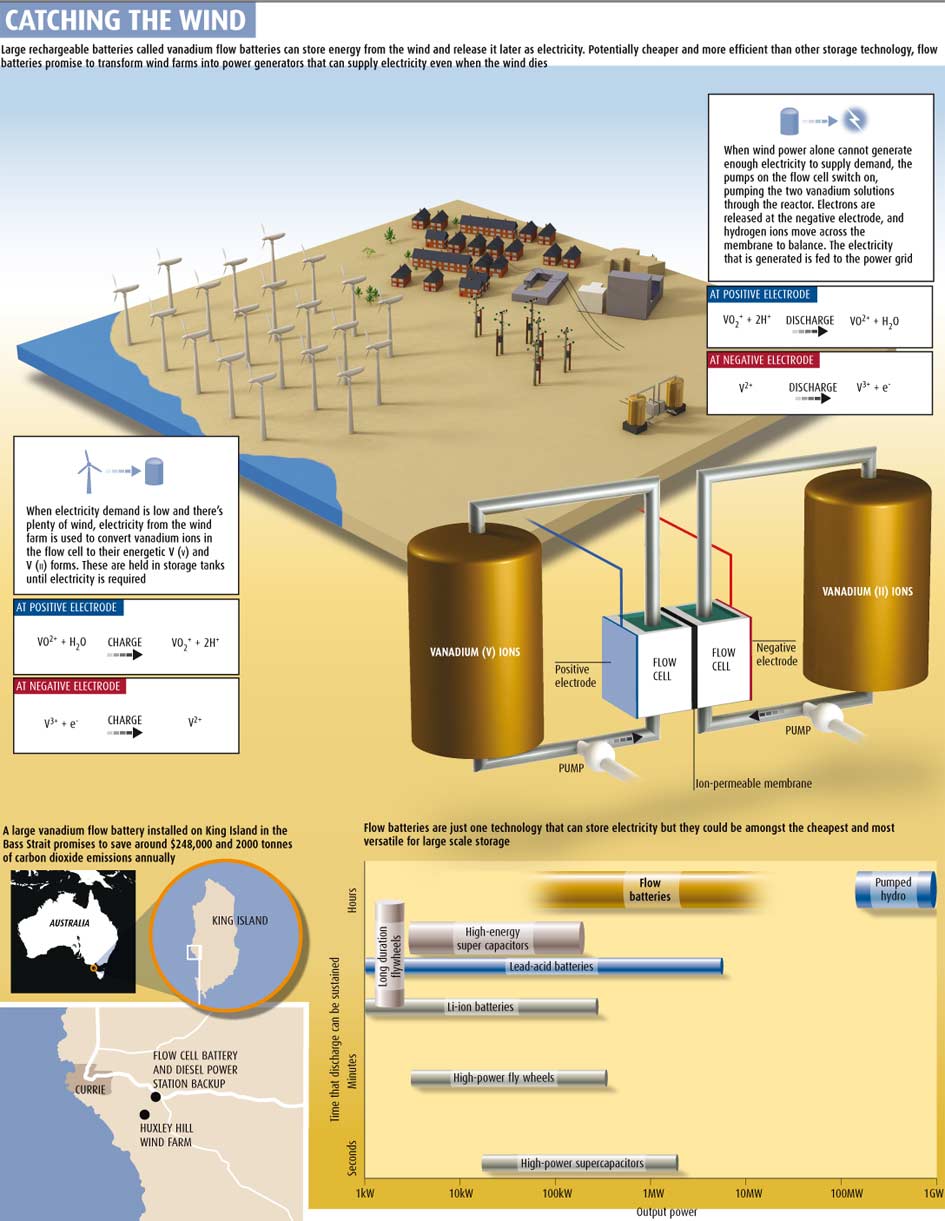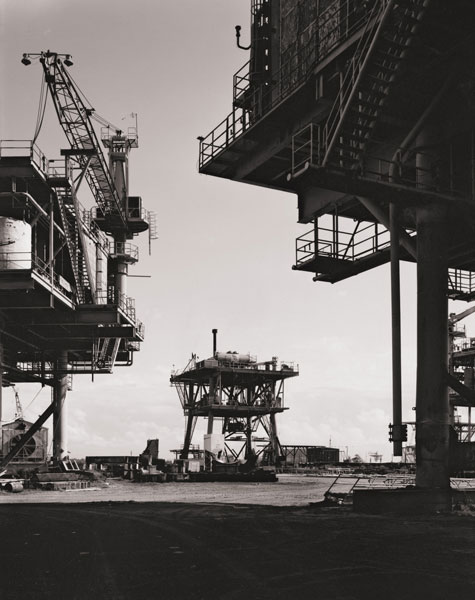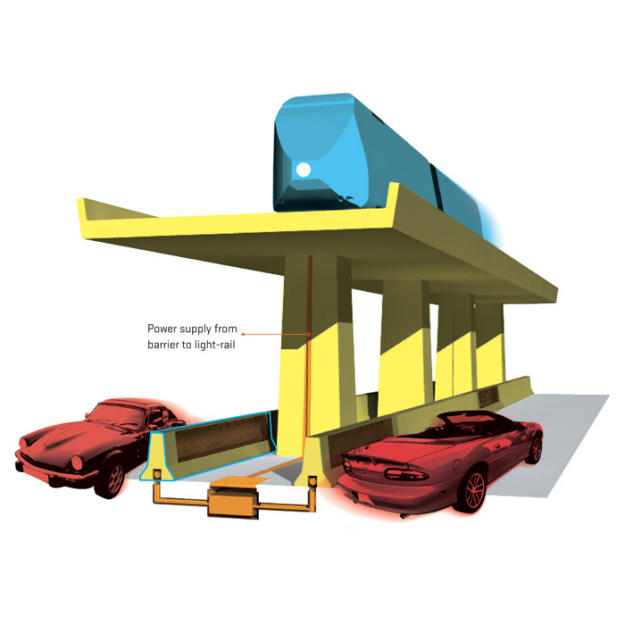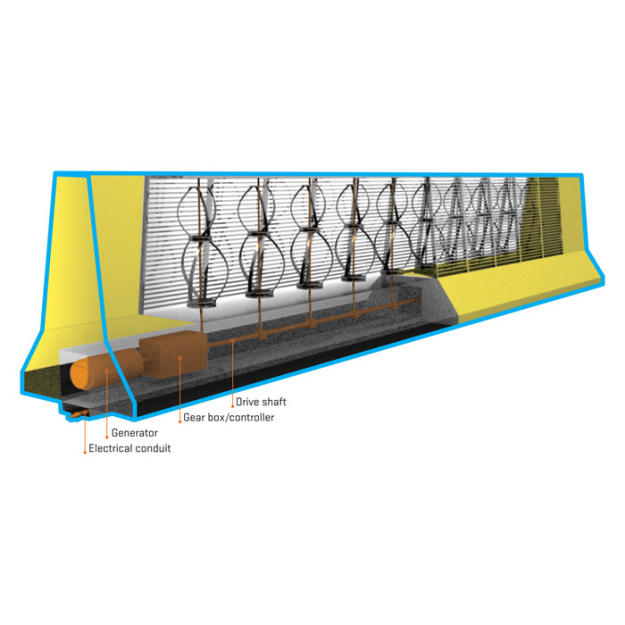The Wind Bank and the Battery
When it was announced at the beginning of January that Australian researchers had developed a kind of wind battery – an "electricity storage system that promises to transform the role of wind energy" – I immediately thought of a scene from Virgil's Aeneid.
 [Image: The wind bank and the battery, via New Scientist].
[Image: The wind bank and the battery, via New Scientist].
There, we read about a place called "Aeolia, the weather-breeding isle," where all the winds of the world are stored:
Less abstractly, New Scientist explains how a local utility company on King Island has "installed a mammoth rechargeable battery which ensures that as little wind energy as possible goes to waste":
 [Image: Via Wired].
[Image: Via Wired].
In other words, an offshore energy firm is hoping to "mount conventional windmills on decommissioned oil platforms," and then anchor those platforms, like artificial islands, out at sea, where the planet's winds are at their strongest.
Combining both these stories, though, I can't help but picture a suitably mythic vision of gigantic flow batteries, standing on iron strutworks and gantried legs, like some sci-fi sea-city on the Texas horizon, dispensing power to all those who visit it: a modern-day version of Aeolia, in other words, the weather-breeding isle.
In any case, all of this takes a turn inland when we add yet another article, published last month in Metropolis. Metropolis introduces us to a man named Mark Oberholzer. Oberholzer has proposed "integrating turbines into the barriers between highway lanes," which would thus "harness the wind generated by passing cars to create energy."
 [Image: Via Metropolis].
[Image: Via Metropolis].
By tapping into an otherwise overlooked urban energy source, Oberholzer's plan transforms a space of pollution, waste, and indulgence – i.e. the modern interstate highway system – into a place of energetic productivity.
Better yet, his system capitalizes not on already existing wind patterns, such as those roaring across the ocean waters of the world, but on inland breezes generated by human activity. His highway-based turbines thus exhibit an interesting, if problematic, symmetry when it comes to anthropocentric climate change: these devices rely entirely on the passage of automobiles, even as they generate an electrical supply that doesn't itself burn fossil fuels.
 [Image: Via Metropolis].
[Image: Via Metropolis].
Returning to the Classical theme with which this post started, though, there is one aspect to all of this that perhaps even Homer himself would like to hear. I'm referring to the Anemoi, Greek gods of wind, each associated with one of four cardinal directions. There was Boreas, the north wind; Eurus, the east wind; Notus, the south wind; and Zephyr, the west wind.
To these, though, Oberholzer's highway project would seem to add a new wind, and another direction: the wind of Man and Cities, those agitated inland breezes from our architectural world, where constant motion now generates its own unruly weather.
An even larger symmetry opens up here, then, when we realize that Oberholzer's inland winds of highways and boulevards might yet be stored, years from now, in wind batteries like those on King Island, Australia.
In other words, these new winds of modernity – urban weather – would be welcomed back into the embrace of King Aeolus, tying the knot, joining those older breezes locked deep inside the isle of Aeolia, where their energy will be stored for another day.
(This post originally appeared on Worldchanging).
 [Image: The wind bank and the battery, via New Scientist].
[Image: The wind bank and the battery, via New Scientist].There, we read about a place called "Aeolia, the weather-breeding isle," where all the winds of the world are stored:
Here in a vast cavern King AeolusIn other words, King Aeolus, "high on a citadel enthroned," ruler of these "contending winds and moaning gales," serves as a kind of literary precedent for the new wind bank project off the coast of Australia.
Rules the contending winds and moaning gales
As warden of their prison. Round the walls
They chafe and bluster underground. The din
Makes a great mountain murmur overhead.
High on a citadel enthroned,
Scepter in hand, he molifies their fury,
Else they might flay the sea and sweep away
Land masses and deep sky through empty air.
In fear of this, Jupiter hid them away
In caverns of black night. He set above them
Granite of high mountains – and a king
Empowered at command to rein them in
Or let them go. (Book 1, 75-89)
Less abstractly, New Scientist explains how a local utility company on King Island has "installed a mammoth rechargeable battery which ensures that as little wind energy as possible goes to waste":
When the wind is strong, the wind farm's turbines generate more electricity than the islanders need. The battery is there to soak up the excess and pump it out again on days when the wind fades and the turbines' output falls. The battery installation has almost halved the quantity of fuel burnt by the diesel generators, saving not only money but also at least 2000 tonnes of carbon dioxide emissions each year.The battery actually works through an ingenious system of chemical mixture and separation. It is thus referred to as a "flow battery":
In the lead-acid batteries most commonly used, the chemicals that store the energy remain inside the battery. The difference with the installation on King Island is that when wind power is plentiful the energy-rich chemicals are pumped out of the battery and into storage tanks, allowing fresh chemicals in to soak up more charge. To regenerate the electricity the flow is simply reversed.Interestingly, this bit of news arrived at the same time as an article about offshore oil rigs, on the Gulf coast of Texas, being retrofitted to act as gigantic windmills.
 [Image: Via Wired].
[Image: Via Wired].In other words, an offshore energy firm is hoping to "mount conventional windmills on decommissioned oil platforms," and then anchor those platforms, like artificial islands, out at sea, where the planet's winds are at their strongest.
Combining both these stories, though, I can't help but picture a suitably mythic vision of gigantic flow batteries, standing on iron strutworks and gantried legs, like some sci-fi sea-city on the Texas horizon, dispensing power to all those who visit it: a modern-day version of Aeolia, in other words, the weather-breeding isle.
In any case, all of this takes a turn inland when we add yet another article, published last month in Metropolis. Metropolis introduces us to a man named Mark Oberholzer. Oberholzer has proposed "integrating turbines into the barriers between highway lanes," which would thus "harness the wind generated by passing cars to create energy."
 [Image: Via Metropolis].
[Image: Via Metropolis].By tapping into an otherwise overlooked urban energy source, Oberholzer's plan transforms a space of pollution, waste, and indulgence – i.e. the modern interstate highway system – into a place of energetic productivity.
Better yet, his system capitalizes not on already existing wind patterns, such as those roaring across the ocean waters of the world, but on inland breezes generated by human activity. His highway-based turbines thus exhibit an interesting, if problematic, symmetry when it comes to anthropocentric climate change: these devices rely entirely on the passage of automobiles, even as they generate an electrical supply that doesn't itself burn fossil fuels.
 [Image: Via Metropolis].
[Image: Via Metropolis].Returning to the Classical theme with which this post started, though, there is one aspect to all of this that perhaps even Homer himself would like to hear. I'm referring to the Anemoi, Greek gods of wind, each associated with one of four cardinal directions. There was Boreas, the north wind; Eurus, the east wind; Notus, the south wind; and Zephyr, the west wind.
To these, though, Oberholzer's highway project would seem to add a new wind, and another direction: the wind of Man and Cities, those agitated inland breezes from our architectural world, where constant motion now generates its own unruly weather.
An even larger symmetry opens up here, then, when we realize that Oberholzer's inland winds of highways and boulevards might yet be stored, years from now, in wind batteries like those on King Island, Australia.
In other words, these new winds of modernity – urban weather – would be welcomed back into the embrace of King Aeolus, tying the knot, joining those older breezes locked deep inside the isle of Aeolia, where their energy will be stored for another day.
(This post originally appeared on Worldchanging).





Comments are moderated.
If it's not spam, it will appear here shortly!
as system heat increases
each breeze is partly artifice
a billion auto-butterflies
in every hurricane
Atlanta actually has a variation in use currently, and probably has from some time. I noticed when visiting down there the past couple of years some turbines above the driving lanes in a tunnel on the north side of downtown ATL on Georgia 400 near Buckhead. Not sure what they are powering, but they've always interested me.
You forgot to give the name of the personification of man made winds. He is named Eddy.
Brian: Those are most likely ventilation fans used to exchange exhaust-laden air with fresh so that motorists get some oxygen. They consume rather than generate power.
Yeah, those were exhaust fans probably. I've seen them in plenitudes in tunnels in japan. If your point was to prove that this idea is not new, you're right. I remember seeing this idea in popular science back in the nineties. The trick here is selling it, and this version looks like a great and beautiful solution. I think the version in popular science used conventional fans, not these spiral turbines, for starters. If you wired them up to low quantities of leds and had them glow at night, they would make for an awesome civic presence in a city like houston, where this designer is from.
Unfortunately, it probably wouldn't work in LA, as the cars probably have to be going faster than 8 MPH.
Nice poem, hibiscus.
I agree that this idea isn't new; even back in high school - a surprisingly long time ago - I remember talking about capturing wind power from the highways. But it took someone to sketch it out and market it, as all ideas do.
So if you're sitting on a good idea: get it out there.
In the late 1970s, I visited a site in Pennsylvania where a reservoir was used to store energy. During low demand hours, water would be pumped into the reservoir, to be released during high demand hours.
Peter, was that for water control - water use management - or for electricity generation?
PS: Peter, did I ever email this post to you?
Geoff, yes, you sent me that link about the Art Shanty Projects.
The reservoir I mentioned was not for water use management, as it was explained to me. Perhaps it had been constructed for that purpose, but in the 70s, it was used as a hydroelectric "battery."
During low demand hours, it would use electricity (from a nearby PECO nuclear plant) to pump water uphill from the Susquehanna River, which would later be released during high demand hours to generate additional electricity for PECO.
I learned about this from some biologists who were studying the effect of rapid changes in water level on the small organisms living in the shallows. Wish I could find some more details, but all I've got time for is a quick Wikipedia search, and I'm not getting anything other than the names of the nearby nuclear generating stations.
It's the west coast of King Island (which is off south-eastern Australia), not Western Australia.
You're right - apologies. Will fix.
i don't think that this has been mentioned in any posts yet but it goes a bit with all of this and is amazing in itself...
http://arstechnica.com/news.ars/post/20070527-new-stove-generator-refrigerator-combo-aimed-at-developing-nations.html
I’ve seen a number of stories about harnessing wind energy from traffic, but there’s one fatal flaw. Capturing the wind increases the wind resistance on the cars. The result is that the contributing drivers are paying for all of the wind energy with increased gasoline usage. To make matters worse, since the turbine efficiency is less than 100%, they consume more energy from gasoline than they create.
I am a huge proponent of windpower, but on first principles, this idea just can’t work.
Post a Comment